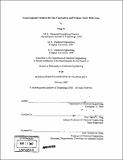| dc.contributor.advisor | Jackie Y. Ying. | en_US |
| dc.contributor.author | He, Hong, Ph. D. Massachusetts Institute of Technology | en_US |
| dc.contributor.other | Massachusetts Institute of Technology. Dept. of Chemical Engineering. | en_US |
| dc.date.accessioned | 2008-11-10T19:53:33Z | |
| dc.date.available | 2008-11-10T19:53:33Z | |
| dc.date.copyright | 2006 | en_US |
| dc.date.issued | 2007 | en_US |
| dc.identifier.uri | http://dspace.mit.edu/handle/1721.1/39347 | en_US |
| dc.identifier.uri | http://hdl.handle.net/1721.1/39347 | |
| dc.description | Thesis (Ph. D.)--Massachusetts Institute of Technology, Dept. of Chemical Engineering, February 2007. | en_US |
| dc.description | Includes bibliographical references. | en_US |
| dc.description.abstract | A nanocomposite system, CuO-Ag/CeO 2, has been successfully developed to complete carbon black combustion by 400*C. This novel catalyst has excellent potential for application in the emission control of soot particulates generated by diesel engines. In this work, CuO was coated onto nanocrystalline supports, such as alumina, ceria, zirconia and titania. The best activity and catalyst reducibility were achieved by CuO supported on CeO2, a material known for its redox property and oxygen storage capacity. A CuO loading of 20-40 wt% presented the optimal balance between CuO content and dispersion, providing for 50% carbon black combustion at 390° C. To further improve the catalytic activity, Ag was introduced as an additive to CuO/CeO2. CuO-Ag/CeO 2 demonstrated superior reducibility. The optimal CuO-Ag loading was 40 wt%, with a Cu/Ag molar ratio of 1.50% carbon black conversion was achieved at 304° C over the optimal catalyst, and complete combustion was attained well below 400° C. A nanocomposite system of nickel aluminate (NiAl20 4), Re and V has been synthesized for propane steam reforming. Nickel aluminate nanocrystals with various Ni/Al molar ratios were prepared by chemical co-precipitation. They were pretreated in H2 prior to propane steam reforming to obtain highly dispersed Ni species. The Al in nickel aluminate acted as a spacer to provide uniform Ni dispersion. The catalyst with a Ni/Al molar ratio of 1.10 showed the highest reducibility and the highest active surface area. It gave rise to the best propane conversion and H2 yield. H2 yield was improved with increasing reaction temperature up to 700*C, and more H2 could be produced at higher H2O/C molar ratios. Various metal promoters were introduced by impregnation or vapor grafting to improve the catalytic activity and coke resistance of the optimal nickel aluminate catalyst. Catalytic activity could be improved by introducing metal promoters in the order of Re > Rh > Pt > Ir > Pd > Ru > V. These selected additives provided increased reducibility and active surface area. In particular, I wt% Re-promoted nickel aluminate gave rise to the best catalytic activity and H2 yield. Although Re was the most effective promoter at improving low-temperature activity, it only lowered the coking rate of nickel aluminate slightly. To inhibit coke formation over Re-promoted nickel aluminate, V was introduced as an additive. The optimal nickel aluminate system with 2 wt% Re and 2 wt% V demonstrated the highest catalytic activity and H2 yield at low H2O/C ratios. Coking rate was reduced dramatically with the V additive, which promoted carbon gasification. The excellent activity, coke resistance and thermal/hydrothermal stability of Re,V-promoted nickel aluminate nanocomposite would be attractive towards H2 generation for fuel cell applications, especially in portable devices. | en_US |
| dc.description.statementofresponsibility | by Hong He. | en_US |
| dc.format.extent | 150 leaves | en_US |
| dc.language.iso | eng | en_US |
| dc.publisher | Massachusetts Institute of Technology | en_US |
| dc.rights | M.I.T. theses are protected by
copyright. They may be viewed from this source for any purpose, but
reproduction or distribution in any format is prohibited without written
permission. See provided URL for inquiries about permission. | en_US |
| dc.rights.uri | http://dspace.mit.edu/handle/1721.1/39347 | en_US |
| dc.rights.uri | http://dspace.mit.edu/handle/1721.1/7582 | en_US |
| dc.subject | Chemical Engineering. | en_US |
| dc.title | Nanocomposite catalysts for soot combustion and propane steam reforming | en_US |
| dc.type | Thesis | en_US |
| dc.description.degree | Ph.D. | en_US |
| dc.contributor.department | Massachusetts Institute of Technology. Department of Chemical Engineering | |
| dc.identifier.oclc | 173612026 | en_US |
